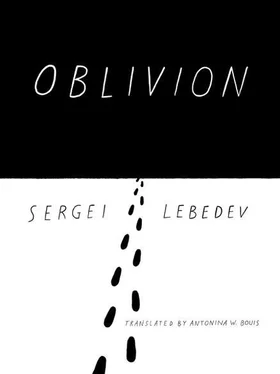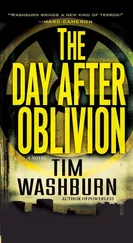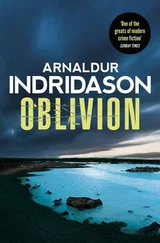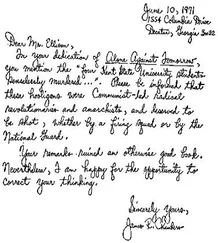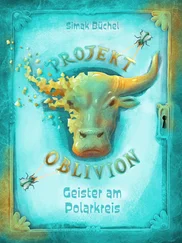If one of the busts had been unfinished or, say, marred by an obvious flaw, the moment would have had a different feeling. But all the Lenins repeated one another without variation, they weren’t even copies, but copies of copies; they had reproduced here, in the cell of oblivion, six steps from the Garden Ring Road, splitting off like amoebas; they had no relation to the real Lenin, each was but a monument of a monument, a bust of a bust.
I realized that the dust everywhere was the dry residue of time; it withered and fell here, fruitless, unable to overcome itself. It seemed that the big Lenins had come first, before the smaller ones: a chain reaction of degeneration was taking place in a hidden crevice, dying time tried to reproduce itself, save itself—and it could not create anything new, not even anything equal to the past.
The real mausoleum was here and not in Red Square; here I understood what the death agony really is—a person doesn’t die right away, but through the extended death of all his “I”s.
The monuments also tried to die, but nonexistence would not accept the multiplied sculptural image which had never been alive as an image, which had appeared stillborn, and it simply grew smaller, and smaller, and smaller. Probably if one were to go down and look, somewhere under the table, under the workbench, under the pile of newspapers, under the rags there would be a rat-sized Lenin, a mouse-sized Lenin, and so on down to the dust particles, which must consist, like chalk, of calcified algae, of micro-Lenins, limestone sculptures visible only under a microscope.
Death-within-death; a dead time—for me that was the multitude of busts on a dusty floor in an abandoned studio; the house was torn down, but the decay was infinite and still continues somewhere.
The second look—through the portrait of Lenin—came in the years when I worked in the North, in the mountains where our expedition was studying old deposits started by the work of prisoners and then abandoned.
The mountains were foggy then; objects lose their material component in the fog and become more image than thing; fog transforms the external world into something similar to the inner world, inhabited by ethereal substances in a spectral environment; whatever you see—a hut, a tripod for land surveying—everything first appears as a symbol floating out of the swirls of foggy murk; the fog seems to present that which is usually hidden—the substantially defined form, the soul of a thing as if it manifested consciousness. And the mind then perceives the object differently: not literally, scanning all its potential imagery and meanings.
It was through a break in the fog that I saw the barracks in a mountain pass. Barely visible through the white mist, they somehow did not seem to belong to a concrete place. Cut out of the landscape, blurred, vanishing at the edge of vision, the barracks came closer without becoming clearer; but the details were not important. From the fog came contours and outlines unburdened by volume—the important part was in the lines.
You can draw a house in which you would not want to live; and you can slightly break the lines of the drawing so that even though it will still be a drawing of a house, there will be something in the lines that Filonov or Kandinsky could understand: the lines will be grief, misfortune, death; it is not the composition that will mean something in total, but each line will express what seems inexpressible in the graphic arts with such clarity it could be a visible sound instead of a line. This will be Munch’s The Scream , but presented not through subject and color, but the agonized scream of geometric figures before their death, hacked apart, squashed in torture vices, stretched on the rack.
The outlines of the barracks appeared to push the barracks themselves into the background; you couldn’t say you were seeing buildings, human dwellings. The barracks stood like plywood cargo crates in which people were stacked, unnaturally long—this correlation of length and width appears only in coffins.
These outlines felt like a long scream, the scream of a form that was suddenly horrified by itself.
In that camp I learned the features of many other places that were present and unrevealed but here displayed themselves with the explicitness of the absolute. They were not literal, physical features, rather they were the features of the emotional sensation that a place makes on us; the features of its sensual and mental portrait.
In the barns of kolkhoz farms, in the Khrushchev-era slums on the outskirts of cities, in railroad station warehouses, in the one-story village houses and the houses of worker settlements, in sheds, in provincial hotels, in timber offices, in army dormitories, in district hospitals, and in many other buildings scattered across the country, I intuitively recognized those camp barracks. They were hidden inside the buildings, clad in pathetic architectural dress—and yet they were revealed in general outlines, corners, and most important in the sense of deadly (and I don’t mean that figuratively) dreariness.
Once I visited a miner’s home; the apartment windows had a view of the refuse heaps of the coal mines—huge cones of tailings, the waste that remained after the minerals are removed. The heaps gave off dust and smoke, and froze: the man lived with a view of the futility of his labor—here is the residue, the wind carries it far, even the monument of a miner in the middle of town had a black dusting on its face; he lived here but this view ate at him, like acid, even if he didn’t think about it. Hence the dreariness, the deadly dreariness—the angst of a man who was only the material or tool of a great construction project.
I experienced the same feeling—multiplied many times—in the mountains; not only multiplied but on a qualitatively different level; the camp barracks, the heaps from adits, the horizontal tunnels on the mountain slopes—it expressed a great concept, it was part of a gigantic plan, but when applied to an individual fate it served as a way of making it meaningless.
Slave labor, the lifeblood of the place, was anachronistic in the twentieth century; an anachronism only perpetuates itself, it always falls out of its time and does not participate in it, no matter how active the imitation of participation may be.
But besides the time gap there was also a spatial gap. I understood why they exiled people to the taiga, the tundra: they were crossed out of the general existence of humans, exiled from history, and their death took place in geography, not in history.
Everything there was made so that the place where people lived and died would not absorb anything from their lives, so that the place would have no attraction, not even a weak one. There was nothing there to elicit compassion, nothing for feeling to cling to—and that was the irreparable harm.
Just wood and stone all around; gray slate, lichen-covered and soggy in the rain, and gray planks and logs. The gray color of the wood, with the shimmer of the nap on an expensive coat, was a sign for me; the wood was drying out, like an old man’s muscles, its fibers were beginning to show, and that patina of gray covered it: the muted shine of death. I had seen planks like that in abandoned villages and now here, in the mountains of the North. They resembled—there is no sacrilege here—wooden relics: even if it turned freezing, I would not use them for a fire.
I walked from barrack to barrack: they were built hastily and cheaply, using wooden wedges instead of nails; wood and stone, no iron, no ocher shades of rust. The place was dying with unnatural thoroughness, trying to vanish into nature. I found only one nail, forged and four-sided, its head deformed by many blows. The nail gave me hope that the place would not vanish completely, a trace, a memory would remain; the nail showed that these barracks were not a mirage, a spectral settlement of wind and fog, that there had been people here.
Читать дальше
